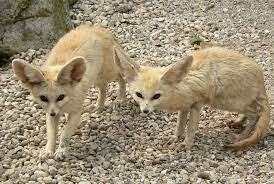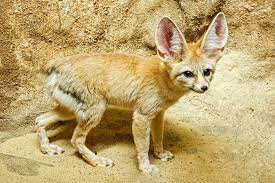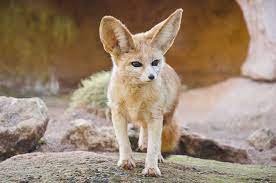Fennec foxes, also known as Vulpes zerda, are captivating creatures inhabiting the arid regions of North Africa. These small canids have adapted remarkably to their harsh desert environments. In this article, we’ll explore 62 intriguing facts about
Fennec Fox these remarkable creatures without specifying the word count.

1. Tiny Stature: Fennec foxes are the smallest fox species in the world, typically weighing between 2 to 3.3 pounds (0.9 to 1.5 kg).
2. Oversized Ears: Their trademark feature is their large, expressive ears, which can grow up to 6 inches (15 cm) long. These ears help them dissipate heat and locate prey underground.
3. Desert Dwellers: Fennec foxes are well-adapted to the desert, with thick fur that provides insulation during cold nights and keeps them cool during the day.
4. Nocturnal Lifestyle: They are primarily nocturnal, which means they are most active during the night.
5. Efficient Hunters: Fennec foxes have keen hunting skills and primarily feed on insects, small rodents, and birds.
6. Lifespan: In the wild, their lifespan is around 4 to 5 years, but they can live up to 14 years in captivity.
7. Unique Vocalizations: They communicate through a series of vocalizations, including barks, screams, and purring sounds.
8. Social Creatures: Fennec foxes are social animals and often live in small family groups.
9. Territorial Behavior: They are territorial and mark their territories with urine and feces.
10. Exceptional Diggers: Fennec foxes are excellent diggers and create elaborate burrows to escape extreme temperatures.
11. Heat Tolerance: They can endure extreme heat, withstanding temperatures up to 122°F (50°C).
12. Keen Sense of Smell: Their sense of smell is highly developed, aiding them in locating prey.
13. Adorable Appearance: Fennec foxes’ cuteness has made them popular exotic pets, but they are not domesticated animals.
14. Conservation Status: They are classified as “least concern” on the IUCN Red List due to their relatively stable population.
15. Short Gestation: Females have a short gestation period of about 50 days, and they typically give birth to 2 to 5 kits.
16. Predators: Their main predators include larger desert carnivores and birds of prey.
17. Long Whiskers: Fennec foxes have long whiskers that help them navigate through the dark.
18. Distinctive Coat: Their pale cream-colored coat helps them blend into the desert landscape.
19. Water-Efficient: Fennec foxes can obtain most of their water from their diet and don’t need to drink often.
20. Excellent Jumpers: They are skilled jumpers, which aids them in catching elusive prey.
21. Playful Nature: Fennec foxes are known for their playful behavior, even in adulthood.
22. Burrow Architects: Their burrows can extend up to 32 feet (10 meters) in length.
23. Mysterious Beginnings: The name “fennec” is derived from the Arabic word “fanak,” which means “fox.”
24. Threats to Survival: Habitat loss and the illegal pet trade are significant threats to their survival.
25. Big Eyes: Their large, dark eyes are adapted for night vision.

26. Speedy Runners: Despite their small size, they can run at speeds of up to 20 mph (32 km/h).
27. Unique Family: Fennec foxes belong to the Canidae family, which includes dogs, wolves, and other fox species.
28. Wild Diet: In the wild, they primarily eat insects like beetles and grasshoppers.
29. Pop Culture: They have appeared in various films, cartoons, and literature, gaining popularity in pop culture.
30. Sensitive Hearing: Their hearing is so acute that they can hear underground movements.
31. Climbing Abilities: Fennec foxes can climb trees and bushes to escape predators.
32. Elongated Canines: Their teeth are adapted for puncturing and holding onto prey.
33. Longevity in Captivity: In captivity, they can live longer due to a controlled environment and diet.
34. Solitary Hunters: While they are social, they often hunt alone.
35. Low Reproduction Rate: They have a relatively low reproduction rate compared to some other mammals.
36. Predilection for Insects: Insects make up a significant portion of their diet.
37. Endearing Appearance: Their fox-like face and huge ears make them incredibly endearing.
38. Limited Vocalizations: Despite being social, their vocalizations are limited compared to some other canids.
39. Feathery Tail: Their tails have a black tip and are often described as “feathery.”
40. Silent Stalkers: They are stealthy hunters and can approach prey quietly.
41. Desert Nomads: Fennec foxes are nomadic, moving from one burrow to another.
42. High-Pitched Calls: Their vocalizations include high-pitched whines and squeaks.
43. Vulnerable Kits: Kits are born blind and deaf and rely on their parents for care.
44. Burrow Hygiene: They keep their burrows clean by regularly removing waste.
45. Cultural Significance: In some cultures, they are considered symbols of cunning and intelligence.
46. Limited Distribution: Fennec foxes are primarily found in North Africa.
47. Threatened Ecosystems: Their presence in ecosystems helps control insect populations.
48. Desert Survivalists: Their adaptations make them incredibly resilient in arid environments.
49. Territorial Marking: They use urine marking to communicate with other foxes.
50. Non-Migratory: Unlike some other desert animals, they don’t migrate in search of water.
51. Unique Fur Coloration: Their fur coloration helps them blend into both sandy and rocky desert terrains.
52. Playful Chasing: Fennec foxes often engage in play chasing with each other.
53. Well-Known Tail: Their long, bushy tails are often seen sticking out of their burrows.
54. Sensitive Pads: The pads of their paws are covered in thick fur, protecting them from hot sand.
55. Hidden Burrows: Their burrows are well-hidden, making them difficult for predators to locate.
56. Family Structure: Kits are cared for by both parents, fostering strong family bonds.
57. Captivating Eyes: Their eyes reflect light at night, enhancing their night vision.

58. Invasive Species: In some areas, they face threats from introduced predators.
59. Swift Escapes: Fennec foxes can make quick escapes into their burrows if threatened.
60. Scent Recognition: They can identify family members by scent.
61. Underestimated Species: Their ecological role is often underestimated but is vital to desert ecosystems.
62. Conservation Efforts: Conservation organizations are working to protect their habitats and raise awareness about these fascinating desert dwellers.



















Add Comment